G’DAY folks, my name is Dane Radosevic and I am a staff member at Davo’s Tackle World Noosa and a sponsored bass tournament angler. I am the 2015 B.A.S.S. Australia Nation Angler of the Year champion and also the Rookie of the Year.
I’m writing to give you an insight into a few proven lures and techniques that have helped me secure consistent results. I have been involved in the bass fishing tournament circuit for just over three years now.
When I started tournament fishing I entered the scene as a non-boater, which is where you rock up without a boat of your own and get paired with a professional angler. Being a non-boater presents a great opportunity for newcomers to learn from the professionals.
As a non-boater I was able to pick the brains of a number of pros, learning many new tricks and techniques to land bass. To gain the most from these opportunities you need to act like a sponge.
The next step is obviously to attain pro status, which really means becoming a boater.
You are then in control of your own boat and a non-boater will join you. I like to have a few key things readily available on my boat when fishing, and scent is one of them. On many occasions when fishing on shut-down fish, I have applied scent and drawn a bite.
Having said that, I have also experienced the opposite, where the scent appears to have turned off active fish. So should you use it or not? Well I start a session without applying scent because I’d rather have a couple of prospect casts, and if I draw a bite or catch a fish I generally won’t apply it.
However, if the fishing is tough, bites are hard to come by or the bite slows, I will then proceed to smear a small amount of scent onto my lure, quite often enticing a bite. Two scents have really worked well for me and they are garlic and shrimp. So yes, make sure you carry some form of scent with you at all times and play around with different types.
Fishing is like a never-ending puzzle and other important pieces of that puzzle are lure choice, colours and technique. Bass, like many species, are affected by seasonal changes and temperature variations, which cause them to inhabit different areas and structures.
This in turn requires us as anglers to be able to chop and change our lure presentations, technique and approach to tempt this more than challenging species into biting. We commonly use well over 15 different lure presentations on the tournament circuit and I believe three of these should be staples in the lure box.
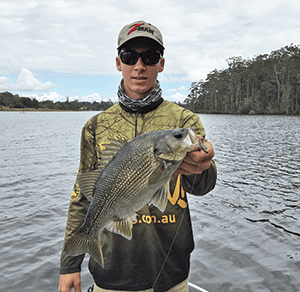
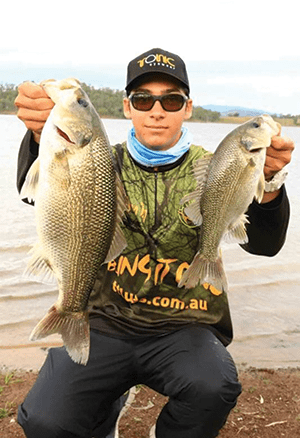
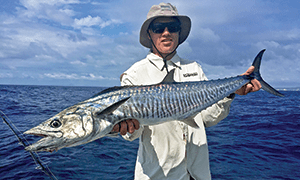
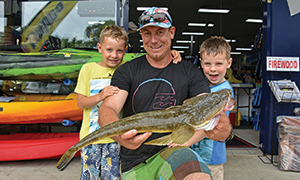
Fishing a plastic to an edge is most effective in clear water with healthy weed beds. A 2”-3” paddle-tail plastic of some description in natural green or brown colour has proven most productive in this scenario because it imitates a small fleeing shrimp or baitfish.
For this technique to work, correct weighting of the jig head is vital. I generally run a fairly light 1/6oz or 1/4oz head depending on the depth and how thick the weed is. Fishing a lighter jig head allows the plastic to be fished over and ripped through the weed beds without sinking right into them.
For me the most successful retrieve involves casting the plastic and allowing it to sink into the weed before giving the rod tip a few short and sharp shakes to rip the plastic out before proceeding to constantly wind, adding in a couple of shakes every five to 10 winds. I like to fish this technique with my rod tip up, giving me greater control over the plastic’s tracking depth.
My technique is different when fishing a plastic down deep in anywhere from 6-18m of water. First, I usually opt for a very natural pearl or two-tone over pearl colour, preferably with some sort of fleck through it for a little added flash.
Matching jig head weight is very important. I use 3/8oz to 5/8oz jig heads depending on depth and wind, with my favourite weight being 1/2oz. The correct weight allows you to fish your plastic in the strike zone for longer.
Imagine fishing a 1/4oz jig head in 12m of water. You would cast it out and allow it to hit the bottom before beginning your retrieve but due to the light weight, the lure’s trajectory would be angled towards the boat (rather than sinking straight down), only placing the lure in the strike zone for a short part of the retrieve.
By fishing a 1/2oz or similar weight you are able to track your lure at the desired depth, keeping it in the strike zone for most of the retrieve. For this technique I like to fish with my rod tip down.
Moving on to the next lure presentation, a small metal blade is one of my favourite prospecting lures when searching for fish.
A blade allows you to cover more ground, and due to the vibrations it creates, fish are drawn in from further away. This presentation works extremely well during the cooler months when bass move to the deeper portions of the dam and congregate in large schools, holding tight to the bottom.
Fishing a blade using the traditional double-hop retrieve allows you to stay in contact with the bottom, which in turn means the lure will be seen by more fish. Most blades have three holes that allow you to change the positioning of the tow point.
The further you move the clip forwards, the tighter the vibration and the quicker you can work the blade. And vice versa, when moved further back the bigger the vibration and the slower you need to work the lure. Neither tow point is necessarily better than the other, but it pays to experiment each time you’re on the water to see what sort of mood the fish are in.
Depending on their moods and the wind I like to switch between 1/4oz and 3/8oz blades in natural silver and gold colourations. The third and final lure presentation has probably won more tournaments than any other lure on the market: the good-old spinnerbait.
This lure is best fished during spring when chasing a reaction bite from actively feeding bass. I have found it is ideal to fish your spinnerbait to an edge around heavy structure. Its two upturned single hooks make it relatively snag free, allowing it to be cast tight to thick cover and slow rolled out over logs and other objects.
When picking a spinnerbait you have to consider three things: the weight, skirt colour and blade combinations. You want to pick a weight that is going to suit the depth of water and retrieve speed to ensure it tracks at the right depth.
Skirt colour and blade choices vary depending on water quality and terrain. My favourite spinnerbait pattern and one I have had great success on is a two-tone purple over pearl skirt with a tandem blade setup consisting of a silver Colorado blade and a gold willow blade.
Hopefully I have shed some light on targeting bass so you can play around with the things I’ve mentioned the next time you are out chasing them.
For further information on different lure presentations, techniques and how certain dams are fishing, drop in and see me or one of the helpful team members at either Davo’s Tackle World Noosa or Davo’s Northshore Bait & Tackle at Marcoola.
We will do our best to point you in the right direction.
Tight lines and bent spines.
 Bush 'n Beach Fishing Magazine Location reports & tips for fishing, boating, camping, kayaking, 4WDing in Queensland and Northern NSW
Bush 'n Beach Fishing Magazine Location reports & tips for fishing, boating, camping, kayaking, 4WDing in Queensland and Northern NSW
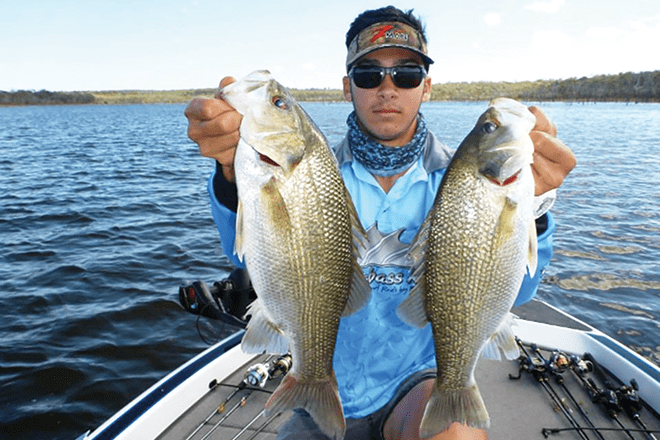








Thanks for the tip about carrying scents with me. Hopefully it helps me out fish my buddies when we go on our annual fishing trip. I certainly wouldn’t have thought of it on my own, especially using garlic.
We’re glad Dane’s advice was of use to you James. Good luck! Cheers, BNB Team